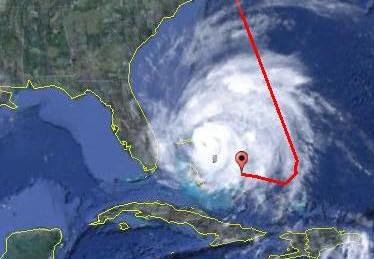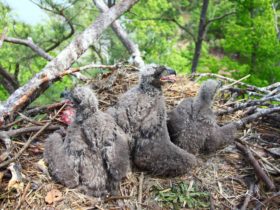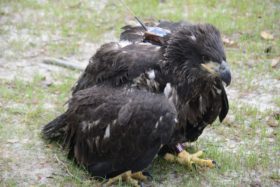Post Hurricane Irene Check In

Scientists Track Shorebird into Hurricane Irene
August 25, 2011Azalea near Langley AFB, Camellia near Back Bay NWR
September 5, 2011
Categories
We’re happy to announce both Bald Eagles survived Hurricane Irene that hit the Eastern US over the weekend. Both maps below can be clicked on to enlarge the image. Red circles indicate the hourly locations and the white arrow is the most recent location. The orange line is the estimated path between hourly locations.
I’m filling in for Reese temporarily. Post any questions in the comments section of the post and I’ll be glad to answer them. – Libby
Camellia hunkered down on the Lynnhaven River in Virginia Beach. Note the green tree icon designating the eagle’s natal territory at the Norfolk Botanical Gardens (upper left corner of the map). The blue arrow shows the location he weathered the storm all day Saturday – a stand of pines off Richardson Rd.
Azalea stayed put at the fish farms in North Carolina and appears to be flying and foraging normally.






21 Comments
YEA!
Thanks for the update Libby!
Thank goodness. Been worrying and waiting for word about them both.
Thank you so much
I’m so happy to know they survived all the wind and rain from Hurricane Irene! Thanks for filling in for Reese and giving me peace of mind!
So why is there a location check in for Cam early this morning (8/31), but nothing for Azalea since 3:15pm Sunday? Is it normal not to show a check in since then?
@GemKitten – The transmitters are collecting GPS location data every hour. The data is stored onboard and then uploaded to satellites every 3 days. I expect to hear from Azalea’s transmitter later today. To see the specifics of how this works check out our EagleTrak website
Libby, thanks so much for posting their wellbeing and whereabouts. Glad our girls are fine!
The Fort Hunt adults are great too. Juvies were mostly gone – so hopefully they will visit… Soon?
Thank you, Libby, for the good news. I’ve been checking every day, hoping for the best.
Libby, Thanks for the updates!
So happy to hear that our Azalea and Camillia are okay after the storm. I guess mom and dad taught them how to survive!!! Thanks for easing the minds of many of us who were concerned.
So glad to hear that the kids are ok. Thanks for letting us know…we are crazy worriers.
Thanks for filling in, Libby. I always look forward to their locations!
Hi Libby. Thanks so much for the update! We’ve all been worrying about “our kids.” I was wondering if there are timestamps for the dots, if you can correlate the juvies’ actitivities with the progress of the hurricane? For example, can you tell that maybe Camellia stayed in the same place for 4 hours during the worst of the storm…or was he flying around then?
@PaulaR – I’ve modified Camellia’s map to show where he was during the storm (see blue arrow). He stayed in a sheltered pine stand the entire day. My guess is he chose a cove on the Lynnhaven River with a group of trees that provide some relief from the wind.
Libby,
Thank you so very much for the updates. Have come to truly respect and appreciate all the information and knowledge you so willingly share with us. Also glad to know you made it through the storm alright hope the same is true for Reese and his wife.
Azalea was the baby that Daddy kept feeding even after her two siblings left the nest. She found that catfish farm and hasn’t moved. Is she lazy or what?
Thanks, Libby.
Thank you…….I’ve been checking every day since Irene to see if they were okay. I am so relieved!!
Checking in from Lithuania in Europe. Relieved to know NBG eagles Azalea and Camellia OK after storm. Seen no eagles so far only Kestrel and Hen Harrier
I am very impress with Camila’s choice to weather the hurricane described by Libby, how smart he is to choose a cove with a group of trees. Also, he is so close to his Dad during the storm.
Thanks, Libby, for modifying the map. Smart eaglet to stay put in a windbreak!
Hello, Reese, good to hear from you! I hope you get to see a Sea Eagle/White-tailed Eagle!
Great article, I hope to continue helping in the knowledge
thanks